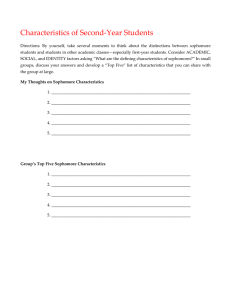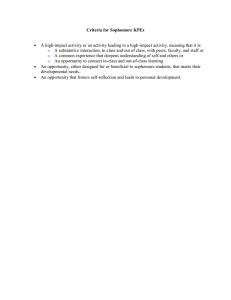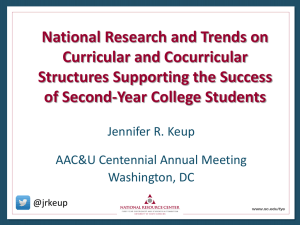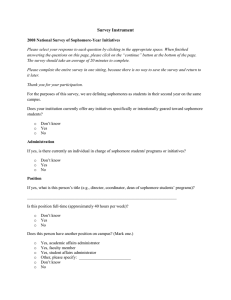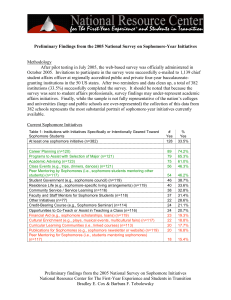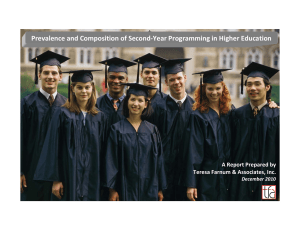FACILITATING STUDENT SUCCESS BEYOND THE FIRST YEAR
advertisement
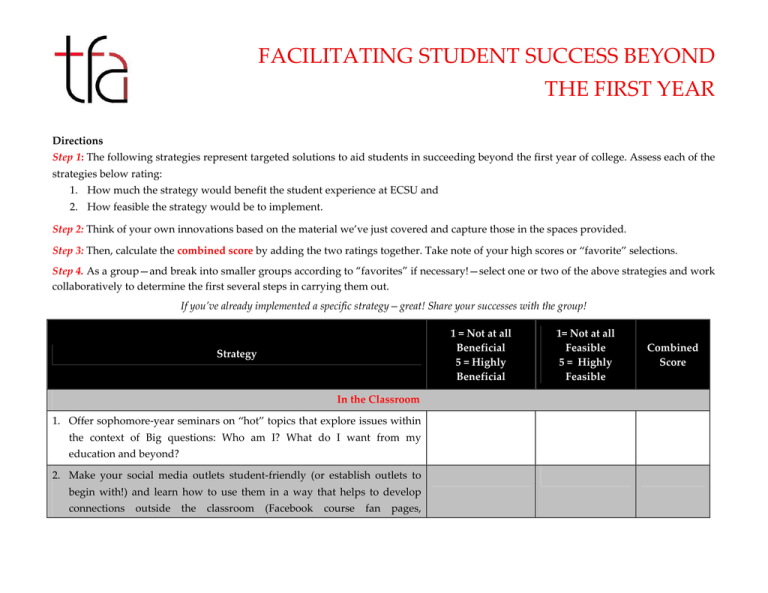
FACILITATING STUDENT SUCCESS BEYOND THE FIRST YEAR Directions Step 1: The following strategies represent targeted solutions to aid students in succeeding beyond the first year of college. Assess each of the strategies below rating: 1. How much the strategy would benefit the student experience at ECSU and 2. How feasible the strategy would be to implement. Step 2: Think of your own innovations based on the material we’ve just covered and capture those in the spaces provided. Step 3: Then, calculate the combined score by adding the two ratings together. Take note of your high scores or “favorite” selections. Step 4. As a group—and break into smaller groups according to “favorites” if necessary!—select one or two of the above strategies and work collaboratively to determine the first several steps in carrying them out. If you’ve already implemented a specific strategy—great! Share your successes with the group! 1 = Not at all Beneficial 5 = Highly Beneficial Strategy 1= Not at all Feasible 5 = Highly Feasible Combined Score In the Classroom 1. Offer sophomore‐year seminars on “hot” topics that explore issues within the context of Big questions: Who am I? What do I want from my education and beyond? 2. Make your social media outlets student‐friendly (or establish outlets to begin with!) and learn how to use them in a way that helps to develop connections outside the classroom (Facebook course fan pages, RemindMe, LinkedIn). 3. Coordinate trips to local landmarks, events, etc. of social, cultural, and/or 4. Consider the syllabus a contract and hold students and yourself political significance. accountable for compliance. Give a quiz on the syllabus, rather than reading it or taking time to discuss. 5. Provide examples of superior work—whether for projects, tests, etc.—that allow students the opportunity to understand expectations of quality. 6. In online and hybrid courses, track student participation through looking at time spent on discussions, site visits, etc., and identity and flag students who have lower participation in these domains. 7. Provide students with performance feedback within the first few weeks of the semester. 8. Require that students complete a learning styles inventory and personality inventory. Discuss results with students and determine implications and strategies for coursework, study habits, etc. 9. Lead study sessions in places outside of the classroom, for instance in coffee shops, parks, etc.—areas that allow students to see you in the context of the larger community. 10. Announce office hours frequently, and hold them without fail. Invite individual students who need help to your office hours (work out an appointment). 11. My own idea: __________________________________________________________________ __________________________________________________________________ Outside of the Classroom/Administrative Options 12. Reach out to the local community to cultivate service learning opportunities and engage sophomores in those opportunities. Offer courses that make use of those connections. 13. Develop undergraduate research opportunities aimed specifically at sophomores. 14. Provide training for advisors (in‐house or externally) on effective sophomore‐year advising interventions (and consider designating a “sophomore advisor”). 15. Sponsor faculty dinners in which faculty lead informal but guided discussions with students about career, internships, etc. 16. Participate in the early‐alert system by making referrals, but also by personally and proactively intervening. 17. Mandate that students meet with advisors and/or counselors several times a semester. 18. Have students develop a four‐year plan of study and sign contracts that outline goals and necessary steps to achieve graduation. 19. Form a sophomore advisory board with key stakeholders (faculty, support services, students, etc.) to research (and stay informed of) sophomore needs at ESCU. 20. Initiate spring/winter break geared toward sophomores that involves travel, exposure to cultural opportunities, community service, etc. that is offered for credit. 21. Reach out to the local community to cultivate service learning opportunities and engage sophomores in those opportunities. Offer courses that make use of those connections. Steps in Implementing Top Strategy(s) Step 1: Step 2: Step 3:
